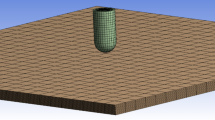Abstract
In the present paper, Charpy impact resistance of aluminum-epoxy laminated composites in both crack divider and crack arrester configurations has been investigated. In both configurations, an analytical investigation has been carried out to evaluate the effects of layers thickness on impact resistance of the specimens. A model based on fuzzy logic for predicting impact resistance of the specimens has been presented. For purpose of building the model, training and testing using experimental results from 126 specimens produced from two basic composites were conducted. The data used for the input data in fuzzy logic models are arranged in a format of 7 input parameters that cover the thickness of layers, the number of layers, the adhesive type, the crack tip configuration, the content of SiC particles, the content of methacrylated butadiene-styrene particles and the number of test trial. According to these input parameters, in the fuzzy logic model, the impact resistance of each specimen was predicted. The training and testing results in the fuzzy logic model have shown a strong potential for predicting impact resistance of aluminum-epoxy laminated composites.
Similar content being viewed by others

Change history
12 March 2021
An Erratum to this paper has been published: https://doi.org/10.1007/s11431-021-1775-1
References
Vaziri R, Quan X, Olson M D. Impact analysis of laminated composite plates and shells by super finite elements. Int J Impact Eng, 1996, 18: 765–782
Liu D, Raju B B, Dang X. Impact perforation resistance of laminated and assembled composite plates. Int J Impact Eng, 2000, 24: 764–773
Howard S J, Pateras S K, Clyne T W. Effect of interfacial adhesion on toughness of metal/ceramic laminates. Mater Sci Technol, 1998, 14: 535–541
Xiao L, Abbaschian R. Role of matrix/reinforcement interfaces in the fracture toughness of brittle materials toughened by ductile reinforcements. Metal Trans A, 1992, 23A: 2863–2872
Lu T C, Evans A G, Hecht R J, et al. Toughening of MoSi2 with a ductile (niobium) reinforcement. Acta Metall Mater, 1991, 39: 1853–1862
Ellis LY, Lewandowski J J. Effects of layer thickness on impact toughness of Al/Al-SiCp laminates. Mater Sci Eng A, 1994, 183: 59–67
McLelland A R A, Atkinson H V, Anderson P R G. Thixoforming of a novel layered metal matrix composite. Mater Sci Technol, 1999, 15: 939–945
Tekyeh-Marouf B, Bagheri R, Mahmudi R. Effects of number of layers and adhesive ductility on impact behavior of laminates. Mater Lett, 2004, 58: 2721–2724
Kaufman J G. Fracture toughness of 7075-T6 and -T651 sheet, plate and multilayered adhesive-bonded panels. J Basic Eng Trans ASME, 1967, 89: 503–507
Goolsby R D. Fracture of crack divider Al/Al laminates. In: International Conference on Composite Materials, TMS, Warrendale, PA, 1978. 941–960
Manoharan M, Ellis L, Lewandowski J J. Laminated composites with improved toughness. Scr Metall Mater, 1990, 24: 1515–1519
Laliberte J F, Poon C, Straznicky P V, et al. Applications of fibermetal laminates. Polym Comp, 2000, 21: 558–567
Akkurt S, Tayfur G, Can S. Fuzzy logic model for prediction of cement compressive strength. Cement Concr Res, 2004, 34(8): 1429–1433
Baykasoglu A, Dereli T, Tanis S. Prediction of cement strength using soft computing techniques. Cement Concr Res, 2004, 34(11): 2083–2090
ASTM E23, Standard test methods noteched bar impact testing of metallic materials. FLual Book of ASTM Standards, ASTM, Philadelphia, PA, 2001
NIST Recommended Practice Guide: Computing Uncertainty for Charpy Impact Machine Test Results, National Institute of Standards and Technology, Boulder, Colorado 80305, 2008
He M Y, Heredia F E, Wissuchek D J, et al. The mechanics of crack growth in layered materials. Acta Metall Mater, 1993, 41: 1223–1238
Cao H C, Evans A G. On crack extension in ductile/brittle laminates. Acta Metall Mater, 1991, 39: 2997–3005
Osman T M, Lewandowski J J. Influence of thickness in the fracture resistance of conventional and laminated materials. Scr Metall Mater, 1994, 31: 191–195
Pandey A B, Majumdar B S, Miracle D B. Laminated particulate-reinforced aluminum composites with improved toughness. Acta Mater, 2001, 49: 405–417
Anderson T L. Fracture Mechanics: Fundamentals and Applications. Boston: CRC press, 1991
Zadeh L A. Fuzzy set. Inform Control, 1965, 8: 338–353
Mamdani E H. Application of fuzzy algorithms for control of simple dynamic plants. Proc IEEE, 1976, 121(12): 1585–1588
Topcu I B, Sarıdemir M. Prediction of compressive strength of concrete containing fly ash using artificial neural network and fuzzy logic. Comp Mater Sci, 2008, 41(3): 305–311
Author information
Authors and Affiliations
Corresponding author
About this article
Cite this article
Nazari, A., Didehvar, N. RETRACTED ARTICLE: Analytical investigations and fuzzy logic-based modeling of the impact resistance of aluminum-epoxy laminated composites. Sci. China Technol. Sci. 54, 2785–2794 (2011). https://doi.org/10.1007/s11431-011-4531-9
Received:
Accepted:
Published:
Issue Date:
DOI: https://doi.org/10.1007/s11431-011-4531-9



